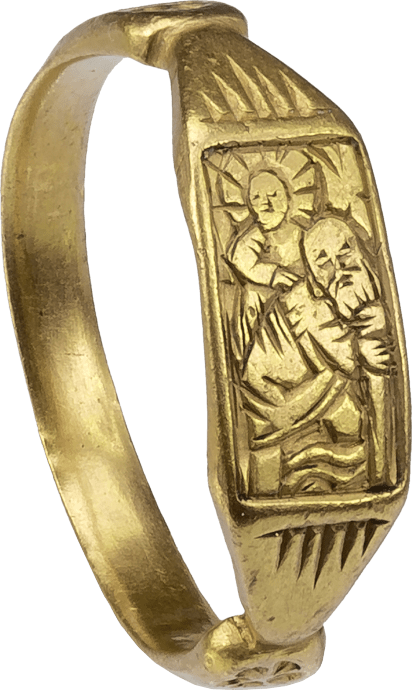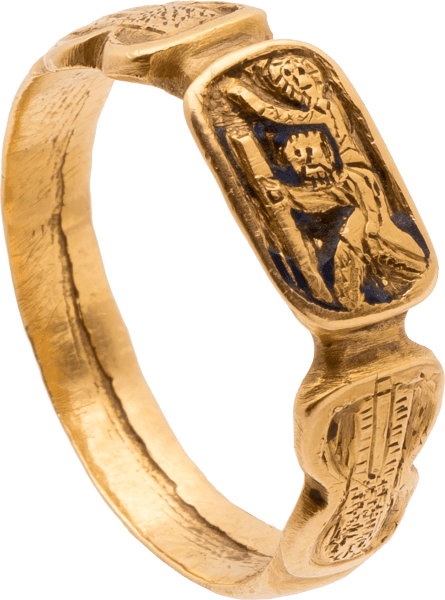


Late Medieval Iconographic Ring with St Christopher and Christ Child
, England, 15th centuryLate Medieval Iconographic Ring with St Christopher and Christ Child
Description
“Iconographic” rings, named for the religious images engraved on them, are increasingly rare, and this example is charming.
Gold ring with D-section hoop on the exterior with twisted and beaded decoration along the lower half, plain on the interior. The hoop is slightly tapered towards the curved shoulders engraved with a five petalled rose and stem. From this rises a triangular support for the flat rectangular bezel with outlined border surrounded by rays and engraved scene of St. Christopher carrying the Christ Child over his shoulder across a river. The ring shows signs of age and is in good wearable condition.
Literature:
In the Middle Ages rings with devotional scenes and favorite saints were worn not only as a sign of faith, they also often had a more personal significance for the wearer. Iconographic rings, a term coined by Victorian collectors, were popular in England in the fifteenth century and worn by both men and women for their devotional, as well as talismanic qualities. The saints chosen on the ring would have been personal to the wearer, either as patron saint, or invoking help against worldly and spiritual dangers, such as natural disasters, protection against illness, and for good fortune. Saint Christopher, widely venerated as patron saint of travelers, also protected against sudden death.
St. Christopher was a popular saint, cf. examples in: British Museum, London (Dalton 1912, no. 741); Victoria and Albert Museum, London (Marian Campbell, Medieval Jewellery in Europe 1100-1500, fig. 86; Church 2011, fig. 16 and inv. nos. 692-1871, M.211-1975; M 239-1962; M 242-1962); Museum of London (62.121/4); Ashmolean Museum, Oxford (Scarisbrick/ Martin Henig 2003, Plate 12, no. 4). For iconographic rings, see: Oman 1964, pp. 54-6; Plates 65 and 66.
A recent study has analyzed the relationship between image and prayer and compared the wearing of iconographic rings with the medieval Book of Hours. Touched and rubbed, fondled in prayer, the medieval iconographic ring offered a tactile device, ever ready and worn on the body, as an aid to private devotion. Iconographic rings were originally enameled, which rarely survives, and many of the surfaces have become indistinct, probably through frequent touch in hope and prayer.
Although we have identified more than 250 extant iconographic rings, they are now relatively rare on the market. See: Sandra Hindman, “Medieval Iconographic Rings: Constructing a Cultural Context,” in Codex Aquilarensis 37 (2021), pp. 485-502.
